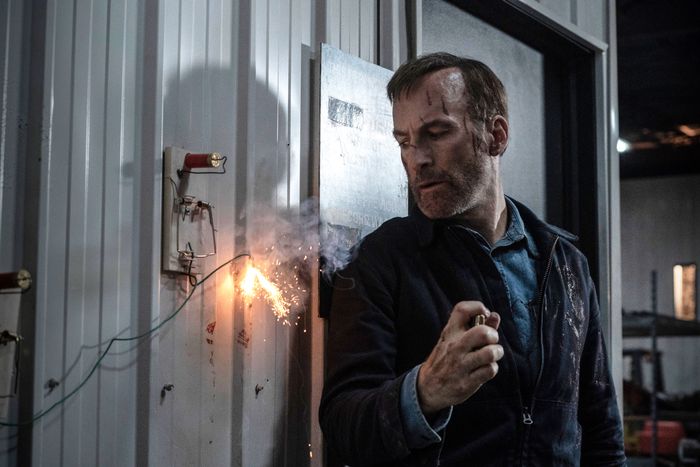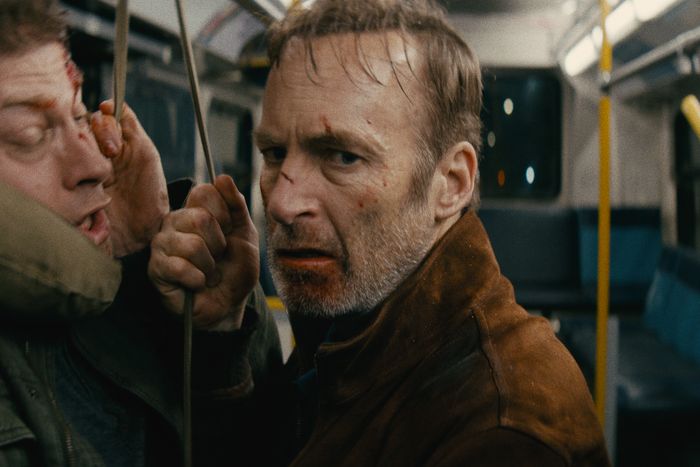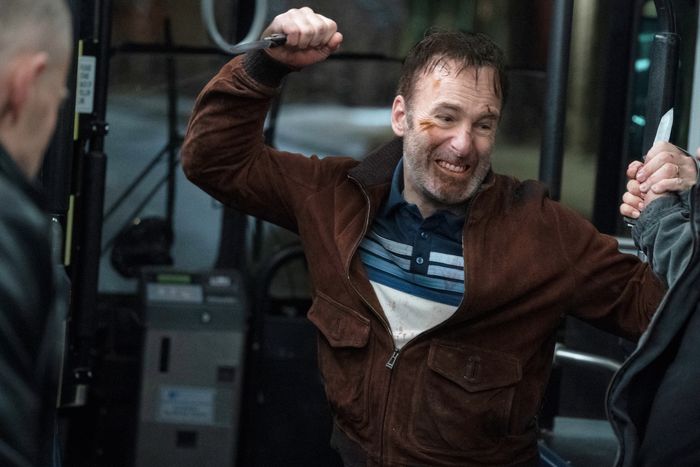
The scene in Nobody when Bob Odenkirk’s character Hutch says, “I’m gonna fuck you up,” to a bunch of thugs on a city bus before taking and throwing his first punches was a crucial moment for the movie’s cast and crew. For the star, it was time to see if two years of intensive training would pay off as he attempted to prove to audiences — and himself — that he could be a legit action hero. For director Ilya Naishuller and his team, shooting the mêlée would determine if the rest of filming would be a success or failure.
“There was always a question of how cute we want to go with the bus fight because the movie will sink or swim on that scene,” Naishuller tells Vulture. “We always knew that. This is the introduction to the other Hutch, the real Hutch, so we really had to make it special.”
Getting that scene right entailed much more than just shooting some cool stunts — viewers had to get emotionally invested as the previously mild-mannered Hutch happily gives in to the violent tendencies he’d suppressed for so long. In addition to Odenkirk’s fight training, the scene took a team of elite stuntmen, fight coordinators, camera operators, and many more crew members who spent three nights filming the battle in frigid Winnipeg. To find out how the Nobody team pulled off this brutal battle, Vulture caught up with Naishuller and Greg Rementer, the stunt coordinator and second-unit director, who were both excited to reminisce about seeing Odenkirk transform into a bona fide badass.
Starting From Square One
When Naishuller got the Nobody script, writer Derek Kolstad, who’s best known for the John Wick films, left the filmmaker with plenty of room to add in all of the stunts and comedic bits that ended up in the final product.
“Derek does this wonderful thing where he keeps descriptions of action scenes very quick and character-oriented. He doesn’t go into many details, but points you in the direction he thinks is good,” says Naishuller. “The most important thing the description said was, ‘Hutch starts off very rusty and then becomes a well-oiled machine, cutting through everybody.’”
With that nearly blank canvas, Naishuller started discussing the scene with Rementer, who’d initially balked at the idea of working on an action movie with Odenkirk. “Naturally, I, like most people, went, ‘You’re out of your mind,’” he recalls, laughing. “They said, ‘But here’s the caveat: Bob’s already been training for a year and a half with this stunt actor, Daniel Bernhardt.’ I got in touch with Daniel, and he passed along this video of Bob training, and I thought, Wow, he has an aptitude for this.”
The first step for Rementer was to observe Odenkirk’s fighting skills and test out various moves that could fit in the scene. “We saw what Bob’s strengths were,” he says. “Before we built any fight choreography, we gathered everybody’s insights about what we want Hutch’s character to feel during this bus fight, because ultimately that drives everything. Nobody cares if it’s a right punch or left punch — they care about the intention behind it. Bob said, ‘I really want this to be a chance for Hutch, who’s a lost man after 20 years of holding back, to come out and put it all out on the table, but to be sloppy.’”
Naishuller had another idea: “As we were pitching it, I said, ‘I want Bob to be the wolverine.’ Not Hugh Jackman’s Wolverine but the animal, because that animal does not stop.”
Adding the Choreography
Naishuller insisted that the entire fight take place within the bus, save for the moment that Hutch is thrown out of the window, to add to the claustrophobia of the scene. “We deliberately did not go for some huge bus. When I got the movie, I went on a ride in L.A. and spent like half a day just seeing what American buses were like,” says the Russian director. “It’s kind of my own version of James Cameron going down to see the real Titanic.”
To plot it out, Rementer replicated the dimensions of the bus, from the walls to the benches, in a gym using two-foot-by-two-foot cardboard boxes, the kind you can buy at Home Depot. This allowed him to choreograph the moves for both the actors and the crew inside the confines of the set, which had removable seats and poles to allow for extra filming space. According to Rementer, working with cardboard is common in the stunt industry due to the way it collapses: “You can fall in on it at an awkward angle. It doesn’t mean it won’t hurt, but it’ll save you.”
On top of coming up with cool moves, Rementer and the team had to work with Naishuller’s three-act emotional arc for the fight. “We have the intro where Bob is gearing up, taking a lot of punches. That ends with him flying onto the bench and the bench collapsing,” says Naishuller, noting that this bit was added as both a joke and a breather for the audience so it’s not just nonstop violence. After ramping up the violence in the second act, the goons eventually gain the upper hand and toss Hutch through a bus window. “That’s the hero at his lowest. We, as the audience, are not sure if he’s going to get back on or just walk away. He has a choice.”
For the final act, Hutch ultimately gets back on the bus and tells a bystander, a young woman, to run away while his assailants realize they’re in for a world of hurt. “A lot of it is one take after that — he’s just plowing through them, knives to faces, knives to legs, very rough and very hardcore. Those five guys on the bus would have done something nasty to that girl and Hutch should never be hurting people that don’t deserve it. It’s a fine balance, because it’s a movie about violence, where you try to make something as dark as it needs to be to tell the story without crossing over into darkness just for darkness’s sake.”
With all that in mind, Rementer then fleshed out the action with his team, which included a stuntman standing in for Odenkirk. “We wanted Bob to be more of like a hammer-fisting kind of guy. He’s really great at them,” says Rementer, who decided to up the brutality and humor of the move by having Hutch do it with his beloved wristwatch wrapped around his knuckles. “Another thing he was really good at was stomping, and there’s nothing more visceral than breaking somebody’s knee backwards. We just kept adding these layers.”
Incorporating these elements, Rementer shot a previsualization of the scene to bring to Naishuller, Odenkirk, and the production team in order to help them conceptualize the final product. “We created this mini-movie in the little box room with sound effects,” he says. “I put in this great classical song because, in my mind, I thought it was like an art piece. It was Bob painting his masterpiece for the first time in 20 years. About 80 to 85 percent of it went right into the movie.”
Nailing the Filming
With the choreography mostly ready and the costuming set — including a suede jacket for Hutch that was a replica of one Naishuller’s dad owned — the director and star kept making tweaks. “Originally, what Derek put on the page was a half-page speech as Hutch takes the bus driver off of the bus, closes the door, and empties the gun,” Naishuller says. “It was a speech about the universe giving you what is owed and it was beautiful, but a couple of days before shooting, Bob and I were rehearsing and I remember thinking, I love the speech and the performance is fantastic but, at this point, all we really want is for you to say, ‘I’m gonna fuck you up.’ We’ve pulled the arrow back enough — let’s just let it fly.”
When it finally came time to shoot the scene, the car crash with the bus goons (as they’re lovingly listed in the credits) took about half a day to film; then it was time for Odenkirk to shine. “For Bob, this is the moment where you’re really gonna know if you’re good enough,” says Naishuller. “He’s the only guy who’s nervous, because we know how good he is.”
“I remember looking at Bob, and he was pacing like a caged tiger. He got his game face on,” says Rementer. “I thought, Oh my God. I think he actually is gonna fuck these guys up. I’m watching and I go over to Kirk Jenkins, who was my co-fight coordinator and one of the guys fighting Bob on the bus — he used to be a fighter. I said, ‘It looks like Bob’s getting into character,’ and Kirk says, ‘Oh my God. I think he’s gonna beat the shit out of us.’”
Then the cameras rolled and the rest of the team’s fears vanished. “We go for the first action beat where he gets punched and it’s working beautifully, just because Bob emotes so well,” adds Naishuller. “That’s the pleasure of shooting a great dramatic and comedic actor in an action role.” At this point, Odenkirk’s training had kicked in — he was going on muscle memory for the fight moves, allowing him to express Hutch’s pain, exhaustion, anger, and glee as he stomps and stabs. “We’re just sitting there with huge smiles on our faces as it’s happening, and I knew that the audience was gonna love it. I remember the childlike excitement of, ‘That’s Bob Odenkirk, he’s beating the shit out of people and he’s looking super great.’ That night, I came home, got my laptop out, and typed the shortest email I’ve ever written: ‘Bob, you’re a fucking action star. See you tomorrow.’”
Throughout the two and a half days of shooting, Odenkirk did almost every stunt, with Naishuller using a double only for two shots, including the one in which Hutch is tossed through the window, a mishap during which led to one of many ideas Odenkirk added to the scene. “We expected the stunt double to go through the window cleanly, but his leg kind of got caught,” says Rementer. “Bob went up to him and says, ‘Oh my God, are you okay?’ and the stunt double was like, ‘Yeah, no worries.’ Then Bob goes, ‘Actually, I think it’s great. Which leg got hurt? I’m going to limp for the rest of the fight.’ He was always in tune with these moments, trying to make his character evolve and get more tired.” The actor also added a slip to the moment, in which he hits his head on a bus pole. “He was adamant about that,” Rementer says.
Those pole and bench hits were accomplished by padding the surfaces with Ensolite, a high-density foam that allowed the actors to bounce all over the bus. Other than that, special effects were mostly limited to fake blood and three knives: a real one, one with a rubber blade, and one without a blade that was added later with CGI. Surprisingly, the toughest shot was the long closeup of Hutch where the camera moves down the aisle. “I wanted it to be a long, smooth motion, but you can’t really throw a dolly in the bus. We tried,” says Naishuller. “To get up and close without a Steadicam was super not easy, so that was technically the most difficult shot.” (As a fun detail, Naishuller also notes that, if you’re paying attention, this shot is the first time Hutch smiles in the entire film.)
With the final product out there and succeeding, Naishuller is happy that others can experience the joy he felt shooting Nobody’s first action scene. “I’m reading reviews, and they’re saying Bob is an action star, and I was like, ‘I called it back in 2019, after the first half a night of shooting. That’s all it took,’” he says. “I would love to take as much credit as possible, but it would not be possible without Bob doing all that work. For Bob, it was a very high-stakes thing, and it was beautiful to see him work so hard. I remember Greg saying to me, ‘You have to value this moment. Not many stars make this much effort.’ So, I’m treasuring Bob.”



